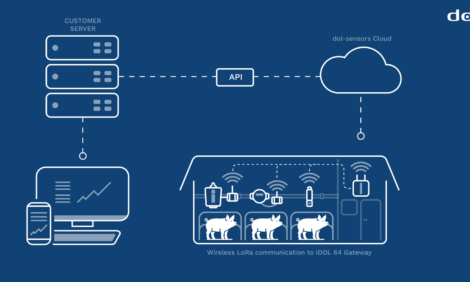



Dietary Omega-6 to Omega-3 Fatty Acid Ratios Affect Protein Deposition in Nursery Pigs
Overall, reducing the omega-6:omega-3 fatty acid ratio improves the efficiency with which piglets can utilise nutrients for growth, according to new research reported in the annual report of the Prairie Swine Centre 2013-14.Summary
An experiment was conducted to determine if decreasing the dietary omega-6 (n-6) to omega-3 (n-3) fatty acid (FA) ratio would affect protein deposition in nursery pigs during a prolonged E. coli lipopolysaccharide (LPS) inflammatory challenge.

Following a one-week long challenge, six-week-old piglets fed a lower n-6: n-3 ratio had increased protein deposition rates, increased liver protein synthesis rates and increased average daily weight gains relative to those pigs consuming a diet with a higher n-6: n-3 FA ratio when feed intakes were similar. Protein synthesis was unaffected by the presence of an LPS-induced inflammatory challenge.
Overall, reducing the n-6:n-3 FA ratio improves the efficiency by which piglets can utilise nutrients for growth, regardless of the presence of an inflammatory challenge.

Introduction
In the swine industry, weaning is a critical time in a pig’s life. They are exposed to a series of stressors (social, environmental, nutritional), which can impact animal health and performance. These stressors can lead to the ‘post-weaning growth lag’ characterised by decreased growth performance, reduced feed intakes, and an inflammatory response. Although a certain degree of inflammatory response is beneficial during this time, an over-production of immune cells can be detrimental, leading to increased muscle degradation and reduced protein synthesis.
Throughout the years there have been many nutritional strategies implemented with the aim of alleviating the stress response of piglets during this time period. Omega-3 FAs are anti-inflammatory, and are pre-cursors for eicosanoid synthesis, and can also alter the production of pro-inflammatory cytokines (proteins secreted by immune cells in response to stimuli) which assist in regulating the inflammatory response. Omega-6 FAs are pro-inflammatory, and thus the ratio between the n-6 and n-3 FAs may be important to establish a well-balanced immune system in these animals.
The objective of this experiment was to determine if decreasing the dietary n-6:n-3 FA ratio would affect protein deposition in nursery pigs during a prolonged E. coli lipopolysaccharide inflammatory challenge, used to model a stress response.
Experimental Procedure

Twenty-four individually housed barrows (21 days of age) were acclimated to one of two dietary treatments for a period of 14 days.
Diets were wheat- and barley-based, and formulated to meet nutritional requirements according to NRC 2012. Total fat was constant across diets; however, the specific FA profile of the diets changed (10:1 n-6:n-3 versus 5:1 n-6:n-3). These changes were accomplished by adjusting the amount of corn oil (high in n-6) and flax oil (high in n-3).
On day 15, within diet, pigs were randomised to an LPS (challenge) or saline (control) injection group. Pigs received either 15μg per kg bodyweight LPS or saline. Repeat injections were given on days 18 and 21. Throughout the challenge period, saline injected pigs were pair fed to the consumption level of LPS-injected pigs.
On day 21, pigs were given a flooding dose of deuterium (2H2O; 4ml per kg body water using an estimate of 72 per cent body water) 1.5 hours post-feeding in order to determine the fractional rate of protein synthesis (FSR). The LPS or saline injections were then given 2.5 hours post-feeding, followed by euthanasia and sample collection (liver, semi-tendinosus muscle and blood) at 5.5 hours post-feeding. Carcasses were then ground and protein and water deposition were determined for the 21-day period relative to an initial slaughter group (ISG) of six pigs. Liver, muscle and blood samples were used to determine the FSR.
Results and Discussion
During the acclimation phase (days 0 to 15), dietary treatment had no effect on feed intake (P>0.10); however, piglet ADG tended to be impacted by dietary treatment, with pigs fed the 10:1 diet gaining 25.0g per day and those consuming the 5:1 diet gaining 28.8g per day (SEM=1.4g per day; P=0.06).
Throughout the challenge phase (days 15 to 18), pigs were pair fed (saline-injected pigs were restricted fed to the level of LPS injected pig intakes), and thus average daily gain and average daily feed intake were similar for all pigs (P>0.10) regardless of diet or challenge group.
Table 1 shows the effects of diet and inflammatory challenge on carcass composition, carcass protein deposition rates and specific protein synthesis rates in pigs with similar feed intakes.
| Table 1. Effects of diet and inflammatory challenge on the carcass composition, carcass protein deposition rates and specific protein synthesis rates in pigs with similar feed intake levels | |||||||||
| Diet (n-3-n-6): | 10:1 | 10:1 | 5:1 | 5:1 | P-values | ||||
|---|---|---|---|---|---|---|---|---|---|
| Challenge: | ISG1 | LPS | Saline | LPS | Saline | SEM | Diet | Challenge | Diet × challenge |
| Number of pigs | 6 | 6 | 6 | 6 | 6 | ||||
| Slaughter bodyweight (kg) | 9.72 | 12.45 | 12.03 | 12.24 | 12.17 | ||||
| Carcass composition (g/kg): | |||||||||
| Protein | 157.42 | 164.19 | 168.13 | 169.31 | 168.21 | 2.215 | 0.25 | 0.53 | 0.27 |
| Water | 741.69 | 739.49 | 730.86 | 727.17 | 724.59 | 3.685 | 0.02 | 0.14 | 0.42 |
| Deposition rate (g/day2): | |||||||||
| Protein | - | 67.20 | 55.46 | 97.45 | 78.08 | 12.193 | 0.04 4 | 0.22 | 0.76 |
| Water | - | 260.58 | 168.65 | 338.54 | 256.04 | 47.306 | 0.10 | 0.08 | 0.92 |
| Deposition rate (g/kg bodyweight gain2): | |||||||||
| Protein | - | 137.91 | 173.93 | 199.10 | 245.55 | 27.720 | 0.03 5 | 0.15 | 0.85 |
| Water | - | 536.27 | 536.03 | 678.57 | 802.69 | 103.620 | 0.06 | 0.56 | 0.56 |
| Nutrition deposition ratio2: | |||||||||
| WDR:PDR | - | 5.26 | 3.05 | 3.31 | 3.25 | 0.836 | 0.31 | 0.19 | 0.21 |
| Protein synthesis rate (% newly made/hour3): | |||||||||
| Semitendinosus | - | 3.83 | 3.26 | 3.19 | 3.13 | 0.272 | 0.17 | 0.27 | 0.36 |
| Liver | - | 5.45 | 6.87 | 9.70 | 7.39 | 1.306 | 0.08 6 | 0.27 | 0.17 |
| 1 ISGs are not included in statistical analysis; values are presented for information only. 2 Carcass composition, deposition rates and deposition ratios were determined for days 0-21 relative to ISG pigs. 3 Protein synthesis rates determined using 2H20 enrichment of the carcass on experimental day 21. 4 10:1 diet PDR (g/d) = 61.33, 5:1 diet PDR (g/d) = 87.76. 5 10:1 diet PDR (g/kg BW gain) = 155.92, 5:1 diet PDR (g/kg BW gain) = 222.27. 6 10:1 diet liver synthesis = 6.16 %/hr, 5:1 diet liver synthesis = 8.55 %/hr. 7 No diet × challenge interactions were present |
|||||||||
For the whole three-week period (days 0 to 21), pigs consuming the 5:1 diet, regardless of challenge group, had higher whole body protein deposition rates relative to pigs consuming the 10:1 diet (87.8g per day versus 61.3g; P=0.04). Similarly, 5:1 fed pigs tended to have increased FSR in the liver on the final day of the challenge relative to those consuming the 10:1 diet (8.55 per cent synthesised per hour vs 6.16 per cent; P=0.08).
There was no effect of LPS challenge on carcass composition, protein deposition rate or on liver or muscle FSR measured using 2H2O enrichment (P>0.05). Protein deposition measured over time and on the final challenge day (FSR) was also unaffected by LPS challenge (P>0.10).
Conclusion
This experiment shows that reducing the n-6:n-3 FA ratio in nursery pig diets improves the efficiency by which the animal utilises nutrients for growth, as evidenced by similar feed intakes but improved average daily gain and protein deposition rates.
Ackowledgement: Strategic program funding was provided by Saskatchewan Pork Development Board, Alberta Pork, Manitoba Pork Council, Ontario Pork and Saskatchewan Agriculture and Food Development Fund. Specific funding for this project was provided by Alberta Livestock and Meat Agency (ALMA) and Vandeputte s.a. (Mouscron, Belgium).
April 2015






